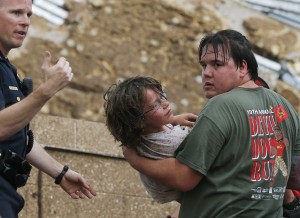
A child is carried from the rubble of the Plaza Towers Elementary School following a tornado in Moore, Oklahoma, Monday, May 20, 2013. The confirmed death toll in the huge tornado is at least 24, an official spokeswoman said Tuesday as she revised earlier reports of 51 or more dead. AP PHOTO/SUE OGROCKI
WASHINGTON—The confirmed death toll in the huge tornado that struck Oklahoma is at least 24, an official spokeswoman said Tuesday as she revised earlier reports of 51 or more dead.
Authorities, however, warned the death toll could climb back up.
Amy Elliott of the Oklahoma chief medical examiner’s office told AFP that 24 bodies had been received and most have been identified. The higher figure had been reported in the immediate aftermath of Monday’s disaster.
Some victims are believed to have been counted twice in the early chaos of the storm, said Amy Elliot, a spokeswoman for the state medical examiner’s office. Downed communication lines and problems sharing information with officers exacerbated the problem, she said, according to AP.
The death toll included at least nine children. Gov. Mary Fallin said an untold number of people were still missing.
“We will rebuild and we will regain our strength,” Fallin said.
The ferocious storm, clocking winds of up to 200 mph (320 kph), ripped through the town of Moore in a central US region known as Tornado Alley, reducing homes to piles of splintered wood. Less than 1 percent of all tornadoes reach such wind speed.
In Washington, President Barack Obama pledged urgent government help.
“In an instant, neighborhoods were destroyed, dozens of people lost their lives, many more were injured,” Obama said. “Among the victims were young children trying to take shelter in the safest place they knew—their school.”
Barren and dark
The storm left scores of blocks barren and dark in Moore, a community of 41,000 people 10 miles (16 kilometers) south of Oklahoma City.
New search-and-rescue teams moved at dawn Tuesday, taking over from the 200 or so emergency responders who worked all night. A helicopter shined a spotlight from above to aid in the search.
Fire Chief Gary Bird said fresh teams would search the whole community at least two more times to ensure that no survivors—or any of the dead—were overlooked. Crews painted an ‘X’ on each structure to note it had been checked.
More than 200 people had been treated at area hospitals.
Other search-and-rescue teams focused their efforts at Plaza Towers Elementary, where the storm ripped off the roof, knocked down walls and turned the playground into a mass of twisted plastic and metal as students and teachers huddled in hallways and bathrooms.
Seven of the nine dead children were killed at the school, but several students were pulled alive from under a collapsed wall and other heaps of mangled debris. Rescue workers passed the survivors down a human chain of parents and neighborhood volunteers. Parents carried children in their arms to a triage center in the parking lot. Some students looked dazed, others terrified.
Officials were still trying to account for a handful of children not found at the school who may have gone home early with their parents, Bird said Tuesday.
After hearing that the tornado was headed toward another school called Briarwood Elementary, David Wheeler left work and drove 100 mph (160 kph) through blinding rain and gusting wind to find his 8-year-old son, Gabriel. When he got there, “it was like the earth was wiped clean, like the grass was just sheared off,” Wheeler said.
Sitting with the teacher
Eventually, he found Gabriel, sitting with the teacher who had protected him. His back was cut and bruised and gravel was embedded in his head—but he was alive.
As the tornado approached, students at Briarwood were initially sent to the halls, but a third-grade teacher—whom Wheeler identified as Julie Simon—thought it didn’t look safe and so ushered the children into a closet, he said.
The teacher shielded Gabriel with her arms and held him down as the tornado collapsed the roof and starting lifting students upward with a pull so strong that it sucked the glasses off their faces, Wheeler said.
“She saved their lives by putting them in a closet and holding their heads down,” Wheeler said.
Authorities were still trying to determine the full scope of the damage.
Roofs were torn off houses, exposing metal rods left twisted like pretzels. Cars sat in heaps, crumpled and sprayed with caked-on mud. Insulation and siding was smashed up against the sides of any walls that remained standing. Yards were littered with pieces of wood, nails and pieces of electric poles.
The National Weather Service issued an initial finding that the tornado was an EF-4 on the enhanced Fujita scale, the second most powerful type of twister. It estimated that the twister was at least half a mile (nearly a kilometer) wide.
The Storm Prediction Center in Norman, Oklahoma, forecast more stormy weather Tuesday, predicting golf ball-sized hail, powerful winds and isolated, strong tornadoes in parts of Texas, Arkansas, Louisiana and Oklahoma. The area at risk does not include Moore.
Monday’s twister also came almost exactly two years after an enormous twister ripped through the city of Joplin, Missouri, killing 158 people.
That May 22, 2011, tornado was the deadliest in the United States since modern tornado record keeping began in 1950, according to the National Oceanic and Atmospheric Administration.